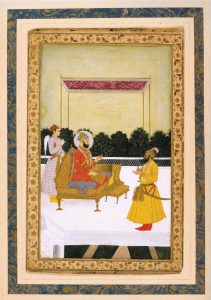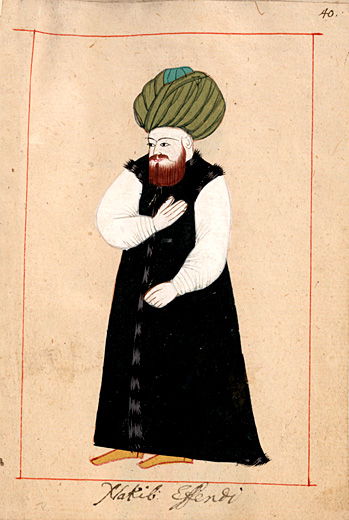Syed (also spelled Seyd, Sayyid, Sayed, Sayyed, Saiyid, Seyed and Seyyed) (pronounced [ˈsæjjɪd], or [ˈsæjjed], Arabic: سيد; meaning Mister) (plural Sadah Arabic: سادة, Sāda(h)) is an honorific title denoting males accepted as descendants of the Islamic prophet Muhammad through his grandsons, Hasan ibn Ali and Husayn ibn Ali, sons of Muhammad’s daughter Fatimah and his son-in-law Ali (Ali ibn Abi Talib).

Syed Hussain Ali Khan Barha was a leading administrator during the reign of the Mughal Emperor Farrukhsiyar
Female syeds are given the titles Syeda, Alawiyah, or Sharifa. In some regions of the Islamic world, such as in India, the descendants of Muhammad are given the title Amir or Mir, meaning commander, general, or prince. Children of a Syeda mother but a non-Syed father are referred to as Mirza.
In the early period, the Arabs used the term Syed and Sharif to denote descendants from both Hasan and Husayn. However, in the modern era, the term ‘Sharif’ (Sharifah for females) has been used to denote descendants from Hasan, and the term ‘Syed’ (Syeda for females) has been used to denote descendants from Husayn.

In the Ottoman Empire, Muhammad’s descendants formed a kind of nobility with the privilege of wearing green turbans.
The Syeds are by definition a branch of the Banu Hashim, a clan from the tribe of Quraish that traces its lineage to Adnan and therefore it is directly descended from Ishmael (Ismâ`îl), as well as being collaterally descended from his paternal half brother Isaac (Isha’aq), the sons of Abraham (Ibrahim). Syeds often include the following titles in their names to indicate the figure from whom they trace their descent. The descendants of Ali and his other wives are called Alvi syed; they are titled Shah, Sain, Miya Fakir or Dewan.
| Ancestor | Arabic style | Arabic last name | Persian last name | Urdu last name |
|---|---|---|---|---|
| Hasan ibn Ali | al-Hasani الحسني او الهاشمي | al-Hasani الحسنيal-Hashemi الهاشمي | Hashemi, Hasani, or Tabatabaei حسنى | Hassani or Hasani حسنی or Hashemi or Hashmi هاشمي |
| Husayn ibn Ali | al-Hussaini1 الحُسيني | al-Hussaini الحسينيal-Hashemi الهاشمي | Hashemi هاشمیHussaini حسین | Hussaini حسينيHashemi or Shah |
| Ali ibn Husayn Zayn al-Abidin | al-Abidi العابدي | al-Abidi العابدي | Abedi عابدى | Abidi or Abdi عابدی |
| Zayd ibn Ali | az-Zaidi الزيدي | al-Zaydi الزيديal-Hashemi الهاشمي | Zaydi زیدی | Zaidi زيديHashemi هاشمي |
| Idris ibn Abdullah | al-Idrisi الإدريسي | al-Idrisi الإدريسي | His descendants are mostly from the Maghreb | His descendants are mostly from the Maghreb |
| Muhammad al-Baqir | al-Baqari الباقري | al-Baqiri الباقري | Baqeri باقری | Baqri باقری |
| Ja’far al-Sadiq | al-Ja’fari الجعفري | al-Ja’fari or al-Sadiq/Sadegh or al-sherazi الصدق او الجعفري | Jafari or Sadeghi جعفرى/ صادقی | Jafri or Jafry جعفریor Sherazi or Jaffery shamsi جعفریشمسی |
| Musa al-Kadhim | al-Moussawi الموسوي او الكاظمي | al-Moussawi or al-Kadhimi الموسوي او الكاظمي | Moosavi or Kazemi موسوى / کاظمى | Kazmi کاظمی |
| Ali al-Ridha | ar-Radawi الرضوي | al-Ridawi or al-Radawi الرضوي | Razavi or Rezavi رضوى | Rizvi or Rizavi رضوی |
| Muhammad at-Taqi | at-Taqawi التقوي | al-Taqawi التقوي | Taqavi تقوى | Taqvi تقوی |
| Ali al-Hadi | an-Naqawi النقوي | al-Naqawi النقوي or al-Bukhari البخاري | Naghavi نقوى | Naqvi نقوی or Bhaakri/Bukhari بھاکری/بخاری |
| Hasan al-Askari | al-Askari العسکري | al-Bukhari البخاري | Naqshbandi نقشبندی or Attar/Atar عطار Sadat سادات | Sadat سادات or Bukhari بخاري |
There are numerous Syeds in Pakistan. Some of these Syeds first migrated to Gardez, Bukhara, and Termez, and then to South Asia. Many settled early in Khyber Pakhtunkhwa, Sindh, and Punjab. There are many syeds of both Shia and Sunni sects of Islam. Amongst the famous Syeds who migrated to this region were Shah Yousaf Gardez of Multan, who came to Multan, Punjab, around 1050 AD. His grandfather, Syed Ali Qaswer, a decedent of Hazrat Imam Jafar Sadiq, the grandson of Hazrat Imam Hussain AS, migrated from Bughdad and was settled in Gardez, Afghanistan. The Gardezis of Pakistan and the Azad of Jammu and Kashmir are his descendants. Other saints include Baba Shah Jamal, Syed Ali Shah Tirmizi, Makhdoom Jahaniyan Jahangasht, Syed Kastir Gul Kaka Sahib of Nowshera, Syed Meeran Hussain Zanjani, Pir Baba of Buner, Jalaluddin Surkh-Posh Bukhari, Shaykh Syed Mir Mirak Andrabi of khanqi Andrabi in Indian occupied kashmir and Syed Muhammad Al-Makki. Syed people of Pakistan are figured as the most prominent and well-established people of the country, with a number of them having become popular and well-known religious icons, political leaders, and professionals. Furthermore, Pakistan currently holds the largest Syed population in all of South Asia. Mashwanis are also living in Pakistan.
The Syeds from Sheraz, Iran migrated to Baluchistan and later to Sindh are known as Sherazi Syed. They are living in Jacobabad and Thatta. The first Sherazi Syed to migrate from Baluchistan to Sindh was Malook Shah who was saint. He is buried near Jacobabad city. Another famous saint of Sindh Mehr Shah was from the lineage of Malook Shah. MPA Aijaz Ali Shah and Ex-Provincial Secretary Arbab Ali Shah are Sherazi Syed.
The Tirmizis, who settled in Pakistan, are mostly descendants of the great Sufi spiritual saint Syed Ali Shah Tirmizi Pir Baba. Pir Baba’s grave and shrine is in Bacha Killay village in the mountainous Buner District of present Khyber Pakhtunkhwa Pakistan. He was also known as “Shāh Kurassan” (“King of Kurassan”).
Source and photo credits: WikiPedia